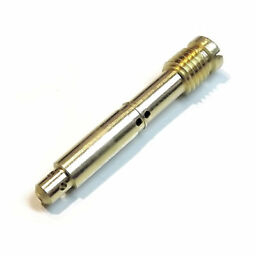Page 1 of 1
starter jets for Webers

Posted:
Sat Jan 16, 2021 2:22 amby chicagojeff
Hey All,
Been searching through old posts for while and can't seem to find the answer to these two questions:
(1) where can I find a starter jet labeled "F5100" for my early Italian-built Weber DCOE 40s, or (2) where can I find something that will work instead?
Listed on one eBay site are some with part # 41205 F5 that look pretty similar, but hard to tell if the part numbering means these will work.
Appreciate any help (or a spare one of these!) Thanks,
chicagojeff
Re: starter jets for Webers

Posted:
Sat Jan 16, 2021 9:53 amby TBG
I get my jets from Webcon UK. They list a starter jet as below. Your part number I cannot find anywhere. Hope that this helps.
Re: starter jets for Webers

Posted:
Sat Jan 16, 2021 10:07 amby nmauduit
Weber jets go by size in 1/100 of mm, e.g. 100 would be 1mm hole
for more complex jets where holes position play a role (with respect to cuve level for example) there are model numbers like Fxy . I suppose the jet you refer to is F5 100 (sounds like a lot)
for my street elan I use
for the idle circuit F8 45
for the emulsion tube F16 , with 135 main and 180 air
PS: sometimes people modify their jets, esp. during the tuning phase, by soldering the hole (lead tin) and drilling a new calibrated hole instead. A photo of your actual jet may help to clear that up (including opening close up)...
Re: starter jets for Webers

Posted:
Sat Jan 16, 2021 11:52 amby TBG
nmaudit - yes, but he is talking about starter jets. Part number 76 on an exploded DCOE diagram.
Re: starter jets for Webers

Posted:
Sat Jan 16, 2021 12:32 pmby nmauduit
TBG wrote:nmaudit - yes, but he is talking about starter jets. Part number 76 on an exploded DCOE diagram.
this jet would be held onto the carb by a hollow screw, so the diagram actually represents 2 parts (jet and screw) - the jet would then be a F5 of size 100 , the screw is the same for all such jets (provided that they are at the correct specs... not all repros jets are)
Re: starter jets for Webers

Posted:
Sat Jan 16, 2021 2:27 pmby TBG
"(1) where can I find a starter jet labelled "F5100" for my early Italian-built Weber DCOE 40s, or (2) where can I find something that will work instead?"
Mnauduit - that was the question! I think I answered it - I do hope so. If he has a carburettor I think we can assume he has the capping screw.
Re: starter jets for Webers

Posted:
Sat Jan 16, 2021 2:51 pmby Craven
Part 41205.101 is the start jet listed for the 40 DCOE 18 on early Elans, it’s a F5 /100 jet.
Start jets are a complete jets screwed in into the body, two per carb.

- Start jet.jpg (18.42 KiB) Viewed 975 times
Re: starter jets for Webers

Posted:
Sat Jan 16, 2021 3:26 pmby chicagojeff
Dear All, thanks for the info. It is indeed a single piece. They went to the separate jet plus threaded cap at some point later in production. I think Craven's answer helps me, that 41205.101 is indeed an F5 100. There's a guy in Italy who has these, so I think I know what to do. Thanks, Jeff
Re: starter jets for Webers

Posted:
Sun Jan 17, 2021 10:01 amby nmauduit
Craven wrote:Part 41205.101 is the start jet listed for the 40 DCOE 18 on early Elans, it’s a F5 /100 jet.
Start jets are a complete jets screwed in into the body, two per carb.
Start jet.jpg
good to know thank's - are the later 2 part models compatible ?
Re: starter jets for Webers

Posted:
Sun Jan 17, 2021 12:09 pmby Craven
nmauduit wrote:Craven wrote:Part 41205.101 is the start jet listed for the 40 DCOE 18 on early Elans, it’s a F5 /100 jet.
Start jets are a complete jets screwed in into the body, two per carb.
Start jet.jpg
good to know thank's - are the later 2 part models compatible ?
Can’t help with that, 2’s 18’s 31’s have one piece jets, 151 has two piece. I do know the one piece jet corrode very badly at the bottom and can be very very difficult to remove.
FWIW



.jpg)